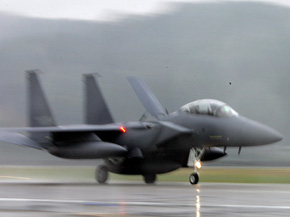 |
|
F-15K fighter jet
|
Incident a snag in Air Force plan to buy ’next-generation’ jets
A Boeing F-15K fighter jet crashed into the East Sea during a nighttime training mission on June 7, killing both occupants, and attention is focused on the cause of the accident. The Air Force indicated the following day that it could delay the purchase of the U.S.-built F-15K fighters if the plane was brought down by mechanical reasons. The Air Force planned to bring in 14 F-15K fighters by the end of this year, as well as introduce an additional 20 by 2009.
Brigadier General Kwon Oh-sung, the Air Force’s spokesperson, announced the crash of the F-15K fighter at a briefing of the Ministry of National Defense. "There was a communication with the crashed aircraft before the incident, but we do not know the cause of the accident yet. A probe is underway based on the flight data, statements of the witnesses and contents of the communication," he said. He said that Boeing promised to cooperate with the Korean military in investigations of the accident. "When Boeing engineers arrive in Seoul, we will jointly investigate the accident," Kwon added.
The Air Force investigation headquarters said that some unexpected situation led to the crash, given that neither of its pilots managed to escape the plane. The F-15K fighter can fly under harsh weather conditions and is equipped with a state-of-the-art navigation system. Despite these features, however, at least 11 accidents involving F-15 fighters have occurred, including incidents in the U.S. and Japan. Among them, three crashes after 2002 reportedly took place because of engine defects.
Unlike regular F-15 fighters in use, the F-15Ks have new GE-manufactured engines. A possible mechanical problem in the GE engine has been raised by critics, as well as the prospect for structural defects caused by the fighter’s modification with the new engine.
There have been concerns of engine problems with the original F-16s, as well, which serve as the main aircraft of the Korean Air Force. A ccording to the Air Force, seven F-16 fighter jets have crashed since they were introduced at the beginning of 1990s, and it was found that all of the crashes were due to engine malfunction.
An Air Force investigation team is probing the possibility of pilot error, as well. Before the F-15Ks arrived here, the veteran pilots of the Korean Air Force had taken test flights, but they might not have adjusted to the new plane’s updated devices, critics say. Brig. Gen. Kwon remarked that the pilots "took part in more than 30 nighttime training missions at Boeing in the U.S."
In the wake of the incident, the Air Force’s ambitious project to introduce next-generation fighter jets, code-named `F-X,’ has hit a snag. Under the 5.6-trillion-won project (5.6 billion USD), the Air Force plans to bring in 40 state-of-the-art fighter jets at over 100 billion won each.
Brig. Gen. Kwon said at the briefing, "We have not yet changed the schedule to bring in 14 F-15Ks from June to December this year, but there will be some measures taken, depending upon results of the investigation," indicating a possibility that there may be an adjustment. The Air Force has decided to stop the flights of all the F-15K fighters until it finds causes of the accident.
Controversies arose since the Air Force first chose the Boeing-made F-15K aircraft as its next-generation fighter jet. Although the F-15K was inferior to the France-based Dassault’s Rafale in an Air Force evaluation in 2000, the F-15K was selected because it displayed a higher level of performance in other fields, including a Korea-U.S. joint operation. On this matter, the Board of Audit and Inspection said that the aircraft selection process was done inappropriately, and F-15K fighter was too expensive, as well.





